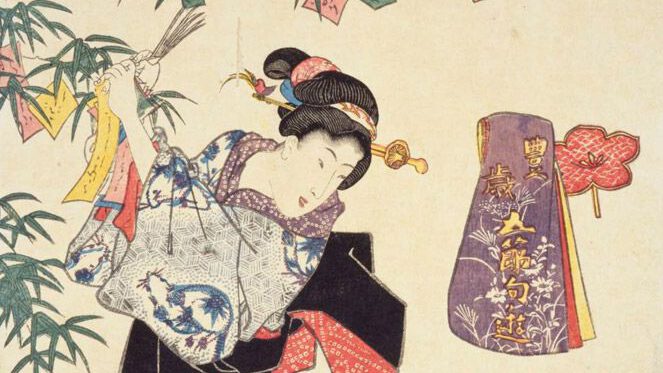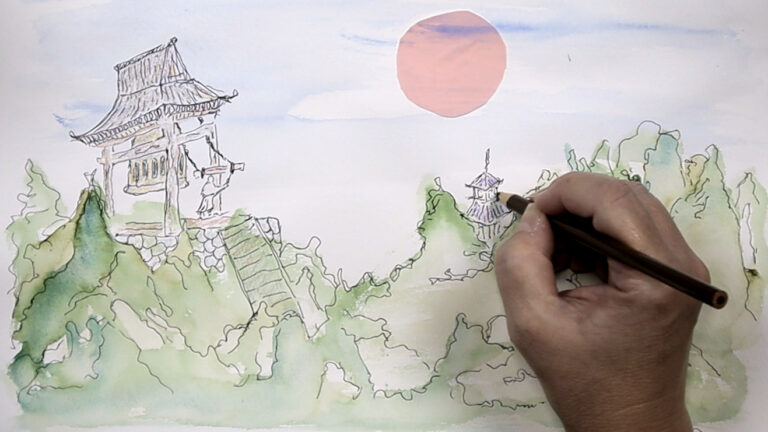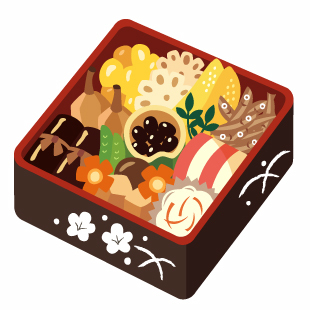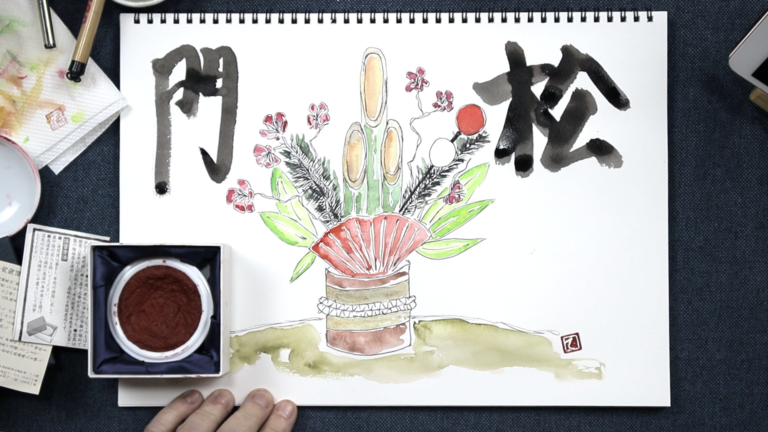On May 5th people all across Japan celebrate Children’s Day or Kodomo no Hi. It might not be a normal year, but if you look out your veranda you can possibly see some carp streamer (koi nobori). One of the ways to celebrate is with an iris bath or shoubu-yu. It’s purported to make you strong like a samurai. Another way to celebrate is for boys to set out a fancy doll. Kintaro is often found in houses all over Japan. He’s also big and strong like a samurai.
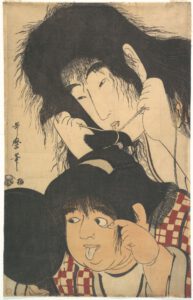
Hey hey, Everyone. How are you holding up?
Do you remember me telling you last episode about a horror audio drama Richard and I are working on? Well, we are. There’s a lot to do for two people. Like writing 11 episodes worth of script, fine tuning that, recording and re-recording everything, getting the sound effects recorded, having music made, putting together the intro and outro to the show, artwork, and all~ the editing that needs to be done. Also, I want to make an enticing trailer to put out. So that, too.
It’s really fun though. I’m not complaining.
But it’s so fun, in fact, that while working on that, in a burst of creativity, I have decided to also do a shorter story, as a warm up to the big one. This one will just be four episodes, and it’ll be based on one of my stories. I’m really excited about this project, too. Again, all the behind the scenes and early releases will go to patrons, because they are my besties.
So let me tempt you with the title of the shorter show first. Ready? It’ll be called The Devil’s Sweet Tooth. And for those who have read my story The Unharmonious Man, you’ll have a bit of an idea what it’s about. Although I’m doing a lot of rewriting, so the same, but different.
Now on to today’s topic.
Okay, looking at the calendar I see we’re fast approaching Golden Week the time of the year when several holidays all line up so much so that employers and businesses just decided to add more days off so people could have an entire week off, or depending on when the holidays fall, longer that a week.
Anyone who lives in or has lived in Japan during a Golden Week knows it’s the time when it’s better not to go anywhere. Because it feels like the entire country takes to the road or the trains and everywhere is much too crowded to really enjoy. Also, you can’t really escape the country either. Because plane ticket prices go way up.
That’s a usual year, this year we’ve got the virus and Prime Minister Abe is imploring people not to travel. I’m not sure how that’s going to go. But I do hope everyone stays home.
I hope people stay home.
Real quick let me tell you the holidays that make up Golden Week. April 29th is Showa no Hi (or Showa Day), May 3rd is Kenpo Kinnenbi, or Constitution Day, May 4th is Midori no Hi or Greenery Day, and May 5th is Kodomo no hi or Children’s Day.
Of all those the most exciting one is Kodomo no hi. Children’s Day, It’s been celebrated forever, but it only became a national holiday in 1948.
The thing I find interesting about kodomo no hi is that it used to be called tango no sekku and was celebrated on the fifth day of the fifth moon
Tango no sekku was less Children’s Day and more Boy’s Day. As my mother in law told me, girls had the Doll Festival on March 3rd, so boy’s had Boy’s Day on May 5th. But then that changed. Now all kids are honored and celebrated and given really cute cakes on May 5th.
You’ve probably seen koinobori. Those brightly colored streamers painted like carp, strung up on poles or across rivers or parks. The cloth blowing in the wind looks like fish swimming. In Chinese myth a carp that swims upstream becomes a dragon and flies off to heaven. And who doesn’t want their little child to grow up and become a proverbial dragon?
This isn’t set in stone, because you’ll see all kinds of colors in different orders, but in general you’ll often find the koibnobori like this from the top: a big black fish for daddy, a red or pink one for mommy, and a blue one for the oldest son. You’ll also see green and orange windsocks for lesser siblings. Okay, I kid. But in old Japan the oldest son, or chounan, was pretty much the best place to be in a household.
Back to kodomo no hi. You’ll often find, usually in the genkan or foyer to a house, dolls for boys put on display in homes all across Japan. And by dolls I mean very intricate and incredibly expensive dolls. Most of them, at least the pricy onces, will be inside a beautiful glass box. These aren’t playing with dolls by any means. Two that are popular for boys are Momotaro (the Peach Boy) and Kintaro (The Golden Boy). I’ll talk more about him in a second. Sometimes a model of a samurai’s helmet or kabuto or suit of armor are displayed instead.
One thing all those displays have in common is they are all are symbols of strength, health and prosperity. Which is what parents wish for their little men.
Before I talk about Kintaro, a couple other Children’s Day traditions that I like.
One is sweets. It seems like with every festival or holiday there is a special sweet that is eaten during that time. With kodomo no hi, it’s either kashiwa mochi or chimaki.
Kashiwa mochi are sticky rice cakes filled with red bean paste or white bean paste with miso and wrapped in oak leaves, that give them a really nice fragrance.
I just learned since it’s difficult to tell which bean paste your getting by just looking at the snack, the trick is that if the leaf is wrapped around the rice cake with the back of the leaf facing outward, so the veins of the leaf are more prominent, then that is red bean paste. If the smooth side or front of the leaf is facing outward, then white bean and miso are inside. That’s pretty cool and I am going to test that theory next time I go to the supermarket. I’ll let you know.
Now in the Kansai or western region of Japan, Oak trees don’t grow naturally so instead of kashiwa mochi they have Chimaki. Chimaki is my favorite of the two. Both the sweet and the savory ones. Although I’m just going to talk about the sweet variety. These are also sweet rice dumplings in different flavors that are wrapped in bamboo leaves. But there shape and the way they’re tied is fun.
They’re rolled long and thin, a little bit bigger on one end, and then wrapped all snuggly in a bamboo leaf with a very thin strip of I think it’s the leaf used for wrapping around and around and tying them. It’s hard to explain but the first time I had one it was a trick to open. But once you learn how, you feel a little smarter.
The good news is now in Japan, I’m guessing in most places you can get both kinds.
Now on to my other favorite thing about Children’s Day. Iris Baths. Irises bloom during May so of course they are a part of the tradition in celebrating your child’s health, success, and long life. Also his or her strength.
Irises are fun. In Japanese they’re called shobu, the same pronunciation with different characters means a duel, or match, game or contest. OR! By two other different characters shobu can mean martial or samurai spirit.
One of the traditions of Kodomo no Hi that I’ve always loved is called shobu-yu. Or Iris bath. A tradition that is thought to have started back in the Heian or Nara Era but really became widespread in the Kamakura Era.
I heard it isn’t done as much anymore, which is a shame. But here’s how it goes.
First, irises have a strong and lovely fragrance that is thought to exorcise evil spirits. So keep that in mind. Remember also that irises, shobu, is a homonym for a duel and martial spirit. And finally, take note that the leaves of the iris are shaped like long swords. Maybe you can see where this is going.
So, by taking a shobu-yu or iris bath you’ll (or more specifically your children) will have a long, disease free life, and become as strong (at least spirit-wise) as a samurai.
Iris baths are believed to also help relax stiff shoulders and relieve back pain, offer greater blood circulation and soften skin. Plus they smell really lovely.
Okay, how to make an iris bath. It’s easy. I don’t know about anywhere else. But in Japan around Kodomo no hi, supermarkets and florists sell bunches of iris leaves, not flowers, just leaves. No special instructions, just draw and bath and soak the leaves. Then you get in, or you kids, however you want to do it. This works wonderfully with the deep Japanese ofuro. And they even have hot springs or onsen who do special shobu yu baths around this time. Usually. Now everyone has to stay home, so probably not this year.
One more thing I wanted to talk about today on this Children’s Day episode, is Kintaro, a Japanese folk hero that you can find everywhere.
You might have seen his likeness. He’s a big, chubby kid with reddish skin and an page boy hair cut with bangs. He’s also naked except for the red diamond shaped bib with the character for gold on it. Kin.
You’ll find his image often with a bear or monkeys, his trusty ax, or a giant carp. All which make appearances in tales about Kin Taro.
Now there are varying stories about Kintaro. First, it’s believed he was a real person, a man named Sakata Kintoki who lived during the Heian Era. Kintoki was a retainer for the samurai Minamoto no Yorimitsu and was well known for being a great warrior.
From there the tall tales began.
Some say he was raised by his mother, a princess named Yaegiri in a town near Mount Ashigara. From there he went on to befriend forest animals and just go about being super strong until he was discovered by the samurai Minamoto no Yorimitsu.
A more exciting version says that his mother fled her house and the town and her husband, and moved to the forest on Mount Ashigara where she raised her son. A version of this story has her leaving her son in the wilds to die, or dying herself thus leaving little Kintaro to fend for himself. Either version ends with him being adopted by a yama uba, mountain witch.
Still another and probably my favorite version of his tale, has the mountain witch being the actual mother who got pregnant by a clap of thunder sent by a red dragon.
It doesn’t sound like Kintaro had any friends of his own species. All his pals were animals. Especially a big ol bear that he often rode around. Some tales say he could speak the animals’ languages. He was also deft at smashing rocks to bits, felling trees with his ax, and sumo wrestling bears to the ground.
Not a big Kintaro fan myself, basically nothing opposes him or makes him interesting, except for having a mountain with for a mom and a red dragon for a dad, I mean he pretty much goes through life unchallenged.
But I wanted to find some special and interesting tidbit to add here, so I did a lot of reading and I found it!
Kitagawa Utamaro was an Ukiyo-e artist who made a lot of pictures of Kintaro and his mother. A lot. But at the time he was creating these images it was the late Kansei Era (1789 to 1801) when it was forbidden to draw, paint or show in any way sexy women.
Now in order to get past this decree, Utamaro got quite clever. He would depict scenes of Kintaro with his very non mountain witch-looking mother doing mother and child things, like she’s doing his hair, feeding him soup, or cleaning his ears. All innocent enough. Then you keep looking and there’s one where she’s sticking her tongue in his mouth, quite a bit of breast feeding, and one where she’s her combing her long hair with little Kintaro on her back and, oh yeah, she’s topless.
I guess that’s less interesting about Kintaro and more about the artist Kitagawa Utamaro. But still.
So, on this May 5th, Kodomo no Hi in Japanese, Children’s Day in English, wherever you are in the world, and no matter how crazy they are making you, because I’ve been there, reach over and give you kid a hug. And if you happen to have sweet smelling irises growing in your garden, chop off those long leaves, rinse them off, and toss them into a nice hot bath. You can have a soak or your can have your children take a bath with them, symbollicaly wishing for a healthy, strong, successful life. I read that using one of the leaves and tying it around your head like a hachimaki, makes the whole thing more effective.
As always, I want to give a great big, fully PPE’d of course hug to my patrons for supporting the show. One bit of odd news: It seems like Japanese mail incoming and outgoing is suspended for all countries, so my upper tiered tengu, oni, and kappa patrons who get the goody envelopes and homemade postcards are still going to get them, just a little later, and all at once; once the mail starks moving again.
I’m still doing monthly folklore Bedtime Stories and recently putting up other content on the Patreon page. Like I just put up a 30-minute long shakuhachi flute performance I recorded awhile ago. The first song he played was Celine Dione’s, My Heart Will Go On. So that was weird.
Thank you for listening and I’ll talk to you all again in two weeks.
Credits
Intro and outro music by Julyan Ray Matsuura

